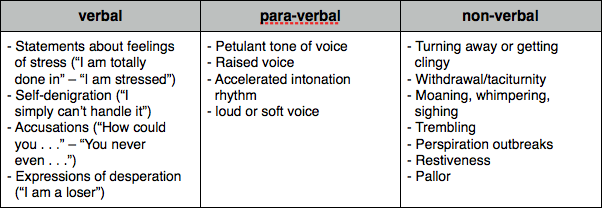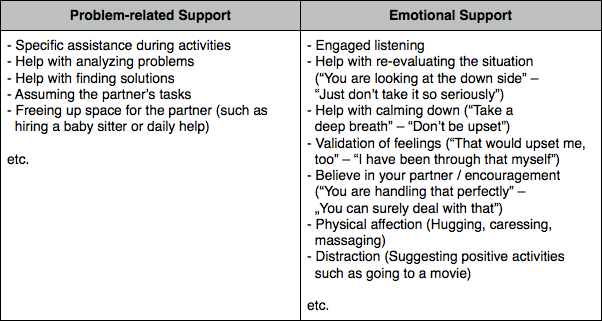Stress and Relationships Part 2

In my previous article on the subject Stress and Partnership I already reflected on about how much your partnership can be taxed by stress. As promised, here are now the first ideas illustrating what good stress management in the relationship can look like. Most of them are out of, or are based on the already mentioned book by Guy Bodenmann (that I would like to again recommend in the strongest terms, but unfortunately only exists in German).
Discover Your Ideal Career Path!
Uncover the careers that align perfectly with your personality with our iPersonic Career Test. It’s quick, insightful, and tailored specifically to help you navigate your career options based on your unique traits.
Take the Test Now!
Recognizing the partner’s stress in time
Many problematic relationship situations are rooted in a simple misunderstanding: One partner feels stressed but does not communicate it sufficiently while the other one does not register it right away or even not at all. When we are stressed we tend to quickly act more irritated, are uptight and more sensitive than normally. At the times when we would have normally just laughed or at least would have kept our cool we angrily cut our partner short. Or, when we would have normally been relaxed, emphatic and supportive, we react petulantly, dismissively or even aggressively. And here we are already joined in a spectacular relationship spat that could easily been avoided had we only been able to better recognize and heed our mutual stress-warning signals and had just treated each other a little more gently.
Stress can be expressed verbally, para-verbally as well as non-verbally, as for instance:

Exercise 1
Take two sheets of paper and a pen. On the first sheet write how and at what level you generally express stress (explaining how your partner would most likely be able to recognize that you are stressed). On the second sheet list the symptoms you believe manifest your partner’s stress. In the meantime your partner does the same. Now you put the sheets next to each other and compare: Are your assumptions correct? Which of your partner’s stress symptoms did you miss and where should you pay more attention in the future? How could you more clearly signal your stress in the future? In order to avoid misunderstandings how could you help each other react more sensitively to your respective stress signals?
Adequately supporting the stressed Partner
You can appreciate that it does not suffice to correctly identify the partner’s stress in a timely manner –in a relationship during times of stress one should support one another as much as possible, have the partner’s back, encourage him/her. After all, you and your partner are a team!
During times of stress there are two important forms of support you can give your partner (and he/she you): subject-related support plus emotional support:

Both forms of support are equally important and justified. Dealing with their partners, especially men often tend to underestimate the importance of emotional support: They mean well and are quickly ready with offering specific problem solutions and then get their feelings hurt when their partner puts them off and groans: “You just don’t get it!” Generally a pretty good indication that in this situation emotional support was lacking. Not everybody needs the same form of support in every situation – that which helps during personal moments of stress is partly a question of personality and life history and naturally also depends upon the situation and what is needed at the time. It is important to develop a good sense for that which the partner needs in terms of support and at what time – naturally it is just as important to indicate to the partner as clearly as possible whatever it is that one happens to need at any given point in time.
Again initially please do the next exercise apart. After each one of you has completed the charts, swap them and discuss the result. What surprised you? What did you like? What scared you? Maybe even made you angry or hurt your feelings? How could you possibly better and more effectively support each other in future stress situations?
Exercise 2

Discover Your Ideal Career Path!
Uncover the careers that align perfectly with your personality with our iPersonic Career Test. It’s quick, insightful, and tailored specifically to help you navigate your career options based on your unique traits.
Take the Test Now!
Joining Forces against the Problem
An extremely important “change of perspectives” a couple should adapt particularly at time of stress: Don’t allow yourself to fall for the mistake of seeing your partner as a part or even as the root of all evil! First of all in most cases this is simply incorrect and unfair and secondly it is a perfect way to drive a wedge between the two of you and undermine the so very important team spirit in your partnership. Instead, join forces against the problem (or problems); see them as the “enemy from without” who is better vanquished together than alone.
This tends to work better if you have a crack at it with a somewhat more structured method of a problem-solving search. At first pass this may appear to be a little artificial, but it is worth the effort.
Exercise 3
- Step 1: Describe the problem as exactly and concretely as possible.
- Step 2: Together search for solutions. Use the same technique employed for brainstorming: The more suggestions, the better – for now nothing is evaluated according to “good” or “bad”, “doable” or “not doable”. At this point criticism is taboo. It helps if each one of you comes up with approximately the same number of suggestions for solutions. Write each suggestion on a separate slip of paper.
- Step 3: Choose the optimal approach to a solution. Now is the time for discussion and criticism! Each one of you says what he/she thinks of each suggestion, evaluates it from his/her perspective regarding its short- and long-term consequences as well as its practicability. At the same time annotate plus- and minus points on the corresponding slips of paper. In this way you’ll come up with the best possible solution for both of you.
- Step 4: Implement this solution into concrete behavior. Here the following questions are to be dealt with: Who does what? As of when do we do this? Where is it going to be implemented? Which obstacles are we probably going to face? How are we going to deal with them?
- Step 5: Implement the found solution in the course of your everyday life. Don’t be too impatient when something does noes not work straight away. If necessary, tweak the solution until it fits the situation. If it turns out that this is not the correct solution, together analyze where‘s the rub and after that proceed together.
- Evaluate your success: Did everything work as planned, what didn’t? Praise and reward each other for the positive change you achieved together.
And that friends, is it for today – nevertheless, we are not yet done with the subject “Stress and Partnership”. Part 3 to follow soon, promise!
This article was written by psychologist and book author Felicitas Heyne. She is the developer of the iPersonic personality test. Take the free personality test now and get in-depth career advice and life coaching from our unique iPersonic personality profiles!
Similar articles in this blog: